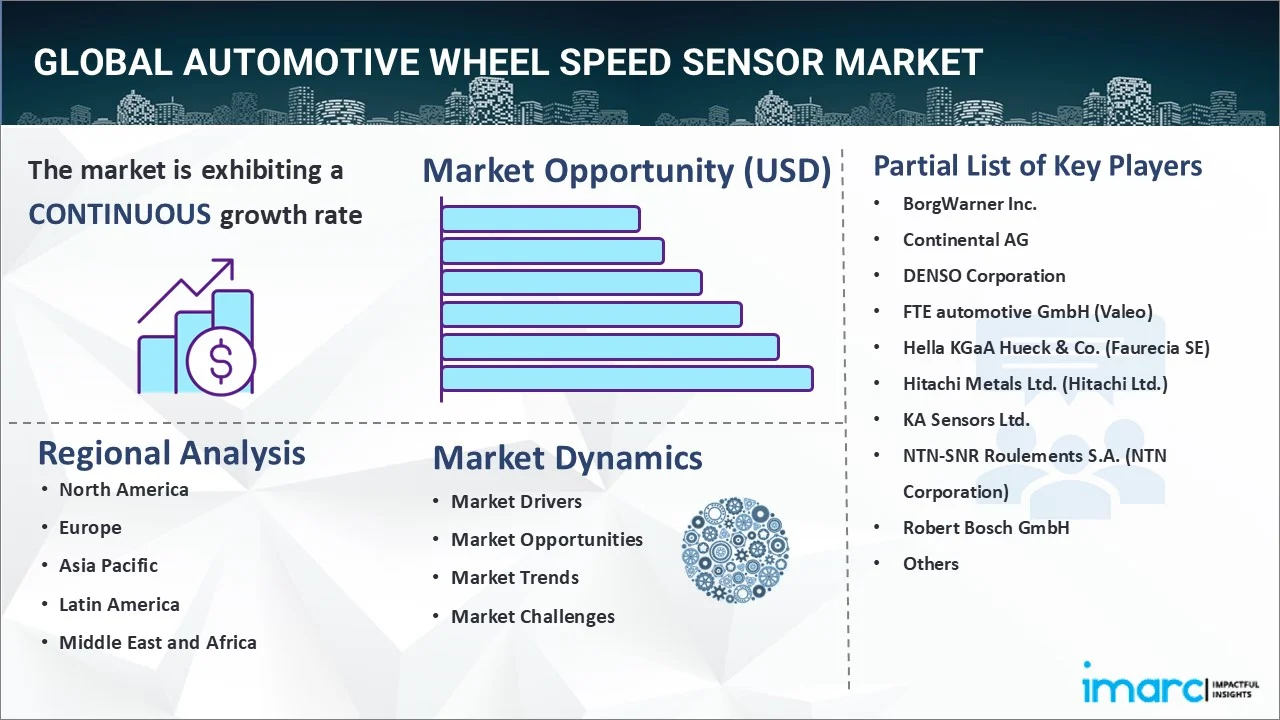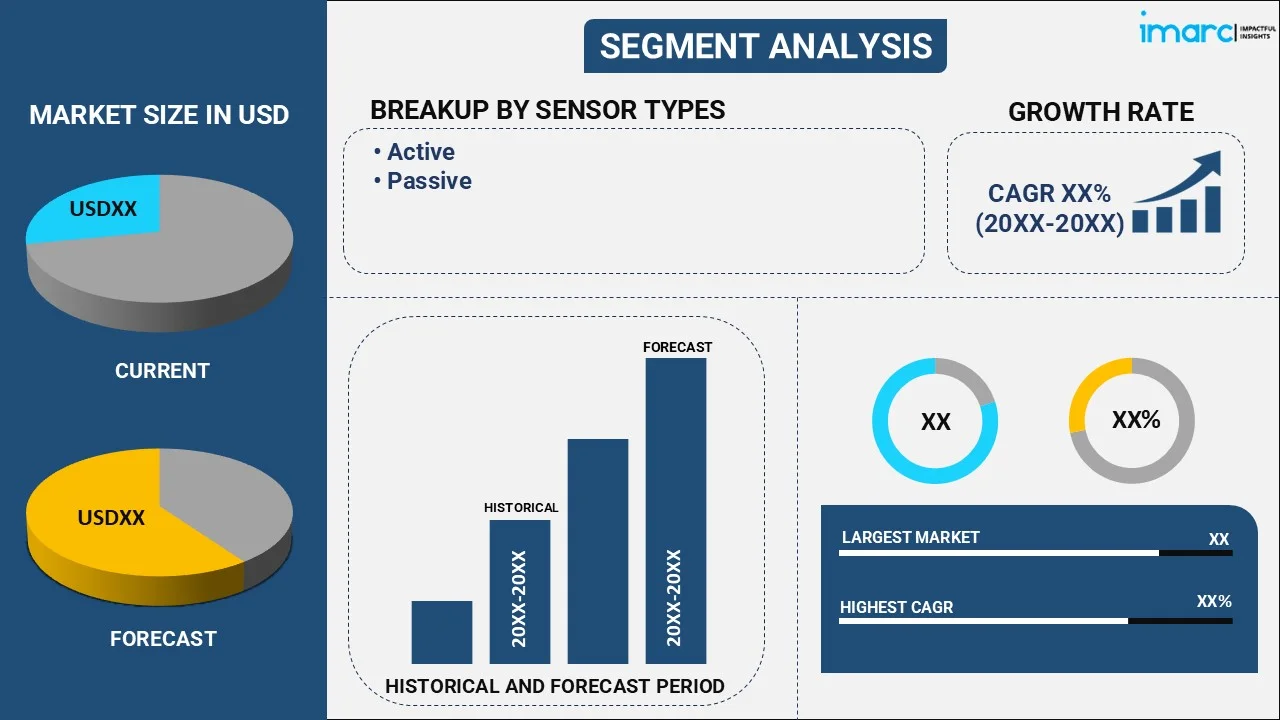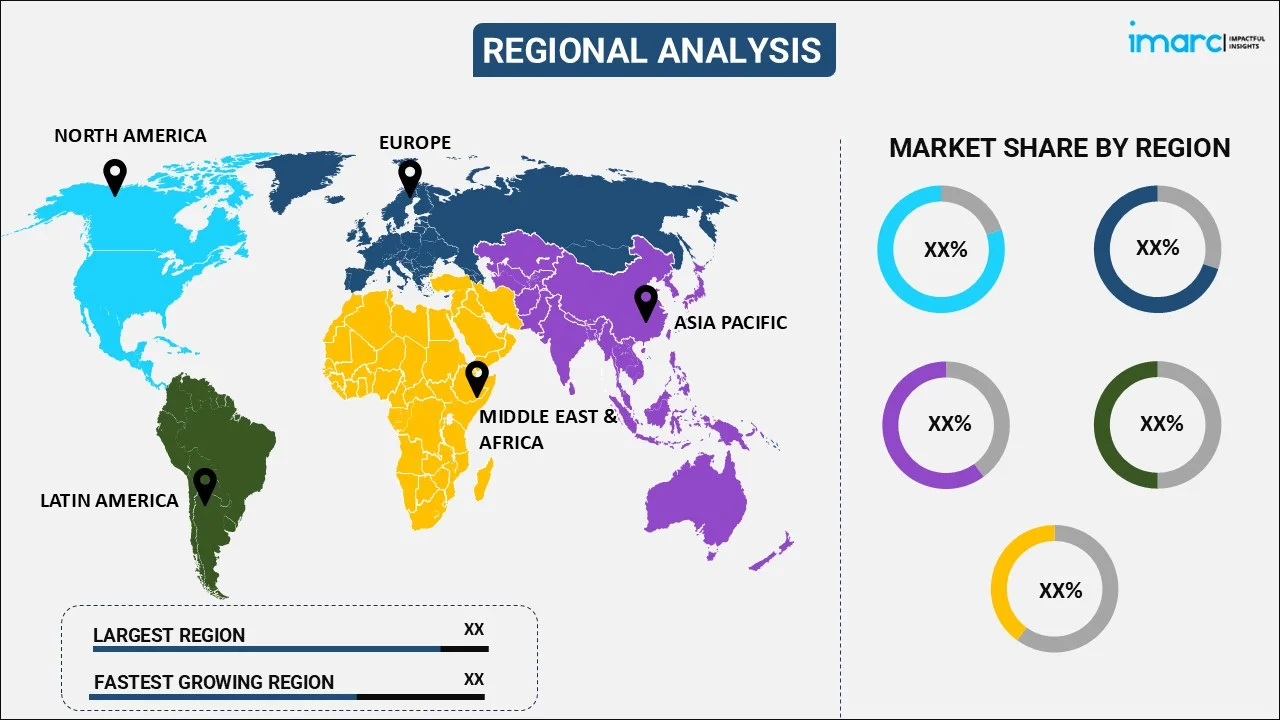
Automotive Wheel Speed Sensor Market Report by Sensor Type (Active, Passive), Vehicle Type (Passenger Vehicle, Commercial Vehicle), and Region 2025-2033
Market Overview:
The global automotive wheel speed sensor market size reached USD 8.0 Billion in 2024. Looking forward, IMARC Group expects the market to reach USD 10.5 Billion by 2033, exhibiting a growth rate (CAGR) of 3.07% during 2025-2033.
|
Report Attribute
|
Key Statistics
|
|---|---|
|
Base Year
|
2024
|
|
Forecast Years
|
2025-2033
|
|
Historical Years
|
2019-2024
|
|
Market Size in 2024
|
USD 8.0 Billion |
|
Market Forecast in 2033
|
USD 10.5 Billion |
| Market Growth Rate (2025-2033) | 3.07% |
An automotive wheel speed sensor (WSS), also known as a vehicle speed sensor (VSS), measures the speed of the wheels and the direction of rotation of cars. It provides input to different automotive systems, including the anti-lock brake system (ABS) and electronic stability control (ESC) using electrical signals. It is installed directly above the pulse wheel, which is connected to the wheel hub or the driveshaft. It helps ensure proper driving dynamics, lower fuel consumption, and reduce gas emissions. At present, the automotive WSS finds extensive applications in passenger cars, light commercial vehicles (LCVs), and heavy commercial vehicles (HCVs) across the globe.

Automotive Wheel Speed Sensor Market Trends:
The increasing utilization of electric vehicles (EVs), in confluence with significant growth in the automotive sector, represents one of the key factors creating a positive outlook for the market. Moreover, the rising road traffic presents numerous challenges to the drivers, and consequently, there is a rise in the adoption of advanced driver assistance systems (ADAS) that optimize safety on the road. Automotive WSS is used in ADAS systems, such as ABS, traction control systems (TCS), adaptive cruise control (ACC), and motor control units (MCU), to determine the wheel speed. Besides this, the optimal interaction of these electronic systems ensures the fault-free function of the vehicle and improves traffic security. Apart from this, governing authorities of numerous countries are mandating the integration of ABS in automotive vehicles, which is facilitating the growth of the market. Other factors, such as the increasing sales of passenger cars around the world and rising improvements in the performance, materials, mechanics, engines and fuels, aerodynamics, and autonomous control in automotive vehicles, are projected to stimulate the market growth.
Key Market Segmentation:
IMARC Group provides an analysis of the key trends in each sub-segment of the global automotive wheel speed sensor market report, along with forecasts at the global, regional and country level from 2025-2033. Our report has categorized the market based on sensor type and vehicle type.
Breakup by Sensor Type:

- Active
- Passive
Breakup by Vehicle Type:
- Passenger Vehicle
- Commercial Vehicle
Breakup by Region:

- North America
- United States
- Canada
- Asia-Pacific
- China
- Japan
- India
- South Korea
- Australia
- Indonesia
- Others
- Europe
- Germany
- France
- United Kingdom
- Italy
- Spain
- Russia
- Others
- Latin America
- Brazil
- Mexico
- Others
- Middle East and Africa
Competitive Landscape:
The competitive landscape of the industry has also been examined along with the profiles of the key players being BorgWarner Inc., Continental AG, DENSO Corporation, FTE automotive GmbH (Valeo), Hella KGaA Hueck & Co. (Faurecia SE), Hitachi Metals Ltd. (Hitachi Ltd.), KA Sensors Ltd., NTN-SNR Roulements S.A. (NTN Corporation), Robert Bosch GmbH, TE Connectivity and ZF Friedrichshafen AG.
Report Coverage:
| Report Features | Details |
|---|---|
| Base Year of the Analysis | 2024 |
| Historical Period | 2019-2024 |
| Forecast Period | 2025-2033 |
| Units | Billion USD |
| Segment Coverage | Sensor Type, Vehicle Type, Region |
| Region Covered | Asia Pacific, Europe, North America, Latin America, Middle East and Africa |
| Countries Covered | United States, Canada, Germany, France, United Kingdom, Italy, Spain, Russia, China, Japan, India, South Korea, Australia, Indonesia, Brazil, Mexico |
| Companies Covered | BorgWarner Inc., Continental AG, DENSO Corporation, FTE automotive GmbH (Valeo), Hella KGaA Hueck & Co. (Faurecia SE), Hitachi Metals Ltd. (Hitachi Ltd.), KA Sensors Ltd., NTN-SNR Roulements S.A. (NTN Corporation), Robert Bosch GmbH, TE Connectivity and ZF Friedrichshafen AG |
| Customization Scope | 10% Free Customization |
| Post-Sale Analyst Support | 10-12 Weeks |
| Delivery Format | PDF and Excel through Email (We can also provide the editable version of the report in PPT/Word format on special request) |
Key Questions Answered in This Report
The global automotive wheel speed sensor market was valued at USD 8.0 Billion in 2024.
We expect the global automotive wheel speed sensor market to exhibit a CAGR of 3.07% during 2025-2033.
The rising demand for automotive wheel speed sensors, owing to their advantageous benefits, such as lowering fuel consumption and reducing gas emission levels, is primarily driving the global automotive wheel speed sensor market.
The sudden outbreak of the COVID-19 pandemic had led to the implementation of stringent lockdown regulations across several nations, resulting in the temporary closure of numerous manufacturing units for automotive wheel speed sensors.
Based on the sensor type, the global automotive wheel speed sensor market has been segregated into active and passive, where active currently holds the largest market share.
Based on the vehicle type, the global automotive wheel speed sensor market can be bifurcated into passenger vehicle and commercial vehicle. Currently, passenger vehicle exhibits a clear dominance in the market.
On a regional level, the market has been classified into North America, Asia-Pacific, Europe, Latin America, and Middle East and Africa, where Asia-Pacific currently dominates the global market.
Some of the major players in the global automotive wheel speed sensor market include BorgWarner Inc., Continental AG, DENSO Corporation, FTE automotive GmbH (Valeo), Hella KGaA Hueck & Co. (Faurecia SE), Hitachi Metals Ltd. (Hitachi Ltd.), KA Sensors Ltd., NTN-SNR Roulements S.A. (NTN Corporation), Robert Bosch GmbH, TE Connectivity, and ZF Friedrichshafen AG.
Need more help?
- Speak to our experienced analysts for insights on the current market scenarios.
- Include additional segments and countries to customize the report as per your requirement.
- Gain an unparalleled competitive advantage in your domain by understanding how to utilize the report and positively impacting your operations and revenue.
- For further assistance, please connect with our analysts.
 Inquire Before Buying
Inquire Before Buying
 Speak to an Analyst
Speak to an Analyst
 Request Brochure
Request Brochure
 Request Customization
Request Customization




.webp)




.webp)












